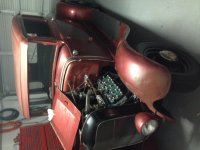rhmc24
Absent Comrade
Kids & Cars
Transportation for most kids in the 1930s was varied - walk - roller skates - bicycle - horse - and for the favored few maybe a motor bike or a home-made something. In the days before rural electricity, washing machines could be had with a small gasoline engine - which sometimes wound up in kid projects. Nothing compared with getting a car.
I loved old cars, antique guns, old anything - but I didn't graduate into hot-rod cars or modern guns. I'm still of a 19th century mindset. I was a pretty good mechanic and could fix most anything, make it run at least for a while.
Somehow I got a Model T Ford at about 14 (1938) for $15 dollars. As I recall my Grandmother was a major contributor making it possible. No car license, no drivers license, no insurance I was living a teenage dream. As I recall kids could get drivers license at 14 that was limited to driving back and forth to school - not that anyone was affected much by that limitation. Full license at 16. In the depths of the depression law enforcement was sparse, interested in real lawbreakers. I do recall a couple kids getting tickets.
Fifteen dollars was about the going price for a Model T if its engine didn't sound too bad, radiator didn't leak much and the tires looked like they would get you home. For a Model A $25. Next I bought a stripped Model T truck for $5, no papers, very bad tires I expected to sell for more. After couple months I sold it for $5 just to get rid of it.
By now about 1940, best car was a 1925 Studebaker originally owned by John Ringling of the Ringling railroad & Ringling Bros. Circus, owned by Ringling's ex-bookkeeper here. In great mechanical shape, a hard top convertible (in modern terms) open above the doors without windows, bought it for $18. Driven daily until recently but had always sat out so we took off the bad top and had a roadster. Tires were a major issue, all worn well into the white fabric breaker strips. It was a heavy car and used a tire common to trucks so we found a tire now and then for fifty cents or a dollar with only a little fabric showing. "We" was a partnership with a schoolmate. Painted green with black fenders we were envied by most of the highschool.
Sale to another highschooler brought it to its sad end at Lake Murray. I should mention that when the lake was made there were section line roads that ran into the lake, now handy for launching boats. A trailer with the boat was backed down close to or into the water, etc. Studebaker was parked on one of these inclines, probably slipped out of gear and slowly rolled down into Lake Murray - where it remains to this day.
My Grandfather had a Model A coupe kept in pristine condition, easily the best Model A in town. Sometimes I would drive him to his office over Collier Bros Furniture, SE corner B and West Main, then drive to highschool and have limited use of the car till I picked him up at 5 oclock. I was proud to be driving such a fine car, so I gave it great care.
Care can be in several forms. A day with no school, I was driving it with a couple other kids toward Lone Grove, West of Ardmore. Behind a very decrepit Model A two-door creeping along, I started to pass. Its left rear wheel came off and ran up under my right front fender behnd the wheel, bending it up about a foot. I confronted the other driver, an almost pitiful man, wife and small child, obviously at the bottom of resources. Almost at least, he gave me his last $1.50 to pay for the damage. We put his wheel back on for him.
I had visions of a huge body shop bill of $20. Studying the damage, it was all a gentle bend with the running board/fender support broken away from the frame of the car. Bought one from a junkie for a dollar, bolted it up to put the fender back like it had always been. One place was rough at an old body putty repair that I concealed with some quick-dry lacquer. All in about two hours. Fortunately my Grandfather never knew. Some days later he saw the rough area which I explained probably some of the kids had stepped on that area when we were hunting.
Something else parents didn't know -- now and then at night we would drive down country roads, one of us sitting on each front fender and shoot rabbits by car lights with our .22s. At the time either the Model A or the Studebaker or some other kid's car.
If a kid had any car that would run you were envied by those who had to walk. Kid judgment of cars was, would it run and not much else - altho the gas it used, appearance and how fast it would go were factors. Speed was a major factor in judging parent's cars - and we tried them out when we got a chance. Model As got about 20 miles per gallon max. Model T about the same but nobody knew because Model Ts didn't have a speedometer. Gas in Ardmore was about 17-19 cents a gallon, out on the edge of town 12 -15 cents. People complained that gas was always cheaper in Davis.
Transportation for most kids in the 1930s was varied - walk - roller skates - bicycle - horse - and for the favored few maybe a motor bike or a home-made something. In the days before rural electricity, washing machines could be had with a small gasoline engine - which sometimes wound up in kid projects. Nothing compared with getting a car.
I loved old cars, antique guns, old anything - but I didn't graduate into hot-rod cars or modern guns. I'm still of a 19th century mindset. I was a pretty good mechanic and could fix most anything, make it run at least for a while.
Somehow I got a Model T Ford at about 14 (1938) for $15 dollars. As I recall my Grandmother was a major contributor making it possible. No car license, no drivers license, no insurance I was living a teenage dream. As I recall kids could get drivers license at 14 that was limited to driving back and forth to school - not that anyone was affected much by that limitation. Full license at 16. In the depths of the depression law enforcement was sparse, interested in real lawbreakers. I do recall a couple kids getting tickets.
Fifteen dollars was about the going price for a Model T if its engine didn't sound too bad, radiator didn't leak much and the tires looked like they would get you home. For a Model A $25. Next I bought a stripped Model T truck for $5, no papers, very bad tires I expected to sell for more. After couple months I sold it for $5 just to get rid of it.
By now about 1940, best car was a 1925 Studebaker originally owned by John Ringling of the Ringling railroad & Ringling Bros. Circus, owned by Ringling's ex-bookkeeper here. In great mechanical shape, a hard top convertible (in modern terms) open above the doors without windows, bought it for $18. Driven daily until recently but had always sat out so we took off the bad top and had a roadster. Tires were a major issue, all worn well into the white fabric breaker strips. It was a heavy car and used a tire common to trucks so we found a tire now and then for fifty cents or a dollar with only a little fabric showing. "We" was a partnership with a schoolmate. Painted green with black fenders we were envied by most of the highschool.
Sale to another highschooler brought it to its sad end at Lake Murray. I should mention that when the lake was made there were section line roads that ran into the lake, now handy for launching boats. A trailer with the boat was backed down close to or into the water, etc. Studebaker was parked on one of these inclines, probably slipped out of gear and slowly rolled down into Lake Murray - where it remains to this day.
My Grandfather had a Model A coupe kept in pristine condition, easily the best Model A in town. Sometimes I would drive him to his office over Collier Bros Furniture, SE corner B and West Main, then drive to highschool and have limited use of the car till I picked him up at 5 oclock. I was proud to be driving such a fine car, so I gave it great care.
Care can be in several forms. A day with no school, I was driving it with a couple other kids toward Lone Grove, West of Ardmore. Behind a very decrepit Model A two-door creeping along, I started to pass. Its left rear wheel came off and ran up under my right front fender behnd the wheel, bending it up about a foot. I confronted the other driver, an almost pitiful man, wife and small child, obviously at the bottom of resources. Almost at least, he gave me his last $1.50 to pay for the damage. We put his wheel back on for him.
I had visions of a huge body shop bill of $20. Studying the damage, it was all a gentle bend with the running board/fender support broken away from the frame of the car. Bought one from a junkie for a dollar, bolted it up to put the fender back like it had always been. One place was rough at an old body putty repair that I concealed with some quick-dry lacquer. All in about two hours. Fortunately my Grandfather never knew. Some days later he saw the rough area which I explained probably some of the kids had stepped on that area when we were hunting.
Something else parents didn't know -- now and then at night we would drive down country roads, one of us sitting on each front fender and shoot rabbits by car lights with our .22s. At the time either the Model A or the Studebaker or some other kid's car.
If a kid had any car that would run you were envied by those who had to walk. Kid judgment of cars was, would it run and not much else - altho the gas it used, appearance and how fast it would go were factors. Speed was a major factor in judging parent's cars - and we tried them out when we got a chance. Model As got about 20 miles per gallon max. Model T about the same but nobody knew because Model Ts didn't have a speedometer. Gas in Ardmore was about 17-19 cents a gallon, out on the edge of town 12 -15 cents. People complained that gas was always cheaper in Davis.
















